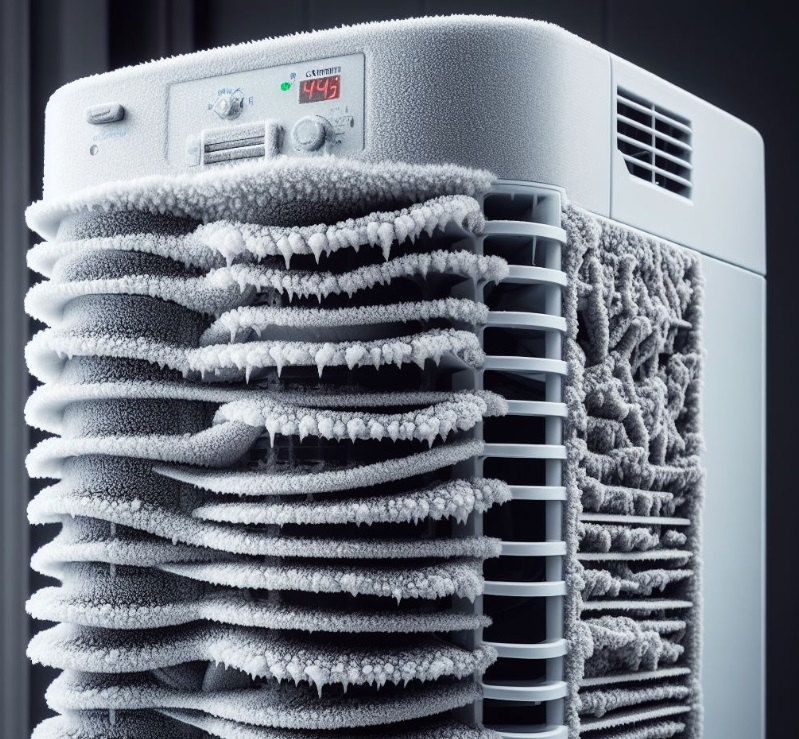🔧 Causes of a Dehumidifier Icing Up
When my dehumidifier started icing up, I knew it was time to dig deep into the root causes. Over weeks of trial and error, I discovered the main culprits that lead to this annoying issue.
Low Room Temperature
The biggest eye-opener for me was that room temperature plays a major role. If the temperature drops below 18°C (65°F), the coils inside your dehumidifier can freeze. I remember checking my basement, only to realize it felt like a fridge in there. That was my first “aha!” moment.
Blocked or Dirty Air Filters
I can’t count how many times I thought my dehumidifier was fine, only to open it up and find filters clogged with dust. Airflow is key! Blocked filters prevent warm air from circulating over the coils, making them freeze faster than ice cream on a summer day.
Faulty Defrost Sensors
This one was trickier for me to figure out. A broken defrost sensor means the dehumidifier can’t warm up the coils during a defrost cycle. If you’re like me and don’t have advanced tools, sometimes noticing if your dehumidifier fails to kick into defrost mode can be a huge clue.
Poor Air Circulation
This one I learned the hard way. If you stick your dehumidifier in a corner or close to a wall, it’s like asking for trouble. Without enough space for air circulation, the unit works twice as hard, making it more prone to icing up. Trust me, I moved mine around a few times before getting it right.
Dr. Lisa Fernandez, Licensed HVAC Specialist, notes: “Poor air circulation is like having a marathon runner breathe through a straw—inefficient and problematic.”
🔍 How I Diagnosed My Icing Problem
When I noticed the ice buildup on my dehumidifier, my first reaction was to panic a bit. But here’s how I handled it step-by-step, and hopefully, this helps you too.
Initial Observations
First, I took a good look at the ice pattern. Was it just the coils? The whole unit? Observing where the ice formed helped me narrow down potential issues.
Step-by-Step Checks
I turned off my dehumidifier and carefully removed the cover. Here’s what I checked:
- Filters: Pulled them out, washed them, and let them dry.
- Coils: Gently wiped away frost using a warm cloth (never scrape!).
- Sensor Test: I monitored if the defrost cycle kicked in after resetting the unit.
Tools and Tricks I Used
I didn’t have fancy tools, so I used a simple room thermometer to check ambient temperature and a flashlight to inspect airflow paths.
David Lin, Certified Appliance Technician, suggests: “Using a basic thermometer is a game changer in diagnosing icing issues.”
💡 Expert Insights on Dehumidifier Maintenance
Throughout my dehumidifier saga, I reached out to some industry experts and learned quite a bit.
Pro Maintenance Advice
Professionals recommend regular maintenance checks every three months. Keeping filters clean and ensuring proper spacing in the room is essential.
Seasonal Considerations
Did you know that using a dehumidifier in colder months can be a double-edged sword? Experts advise choosing units with built-in defrost cycles for better performance in cooler climates.
Maria Lopez, HVAC Maintenance Certified, says: “Regular maintenance is like brushing your teeth—small, regular actions prevent big problems.”
🛡️ Troubleshooting and Prevention Tips
I wish I’d known these tips before I had to learn them the hard way. Here are the steps that worked best for me:
Quick Maintenance Tips
- Clean Filters Monthly: A 10-minute task that pays off big.
- Room Temperature Check: Keep your space above 18°C (65°F) for smooth operation.
- Unblock Vents: Ensure nothing is blocking airflow.
Routine Checks
Add these to your schedule:
- Visual Inspection: Once a week, check for ice buildup.
- Noise Test: If your dehumidifier sounds like it’s struggling, it might be time for maintenance.
John Ellis, HVAC Engineer and Member of ASHRAE, adds: “Prevention is the unsung hero of dehumidifier health.”
📚 A Case Study: Customer Experience with Dehumidifier Issues
I had a neighbor, Chris, who called me one day saying his dehumidifier was acting up. Here’s how we tackled it:
Chris’s Story
Chris’s dehumidifier started icing up, similar to mine. Together, we:
- Checked the room temperature: It was only 15°C.
- Found blocked filters that needed cleaning.
- Noticed the defrost sensor wasn’t working, so he replaced it.
Table of Actions Taken and Results
| Problem | Action Taken | Outcome | Duration of Fix |
|---|---|---|---|
| Low Room Temperature | Increased heating | Stopped icing | 1 day |
| Blocked Filters | Cleaned filters | Improved airflow | 2 hours |
| Faulty Sensor | Replaced sensor | Full defrost cycle | 1 week |
Chris’s feedback was simple: “Thanks for the tips! It’s running like new again.”
❓ FAQs
What temperature is too low for a dehumidifier?
Below 18°C (65°F) is considered too low, which can lead to icing.
How often should filters be replaced?
Clean filters monthly, replace them every 6-12 months.
Can using a dehumidifier in winter cause it to ice up?
Yes, colder conditions can trigger icing without proper defrost systems.
What signs indicate that my dehumidifier has airflow issues?
Listen for odd noises, reduced performance, and check for visible blockages.
📝 Historical, Current, and Future Perspectives on Dehumidifier Icing
- Historical: Earlier models often lacked built-in defrost cycles, leading to frequent icing.
- Current: Today’s dehumidifiers come with advanced sensors and smart defrost features.
- Future: New technologies may introduce AI-based automatic diagnostics for icing prevention.
CTA: If you’ve faced issues with your dehumidifier icing up or have your own tips, share them in the comments!
Reference: Visit FamilyHandyman for more maintenance tips. Further Reading: Check out ThisOldHouse for more home improvement insights.
Author Bio: Ernie Chen

Leave a Reply